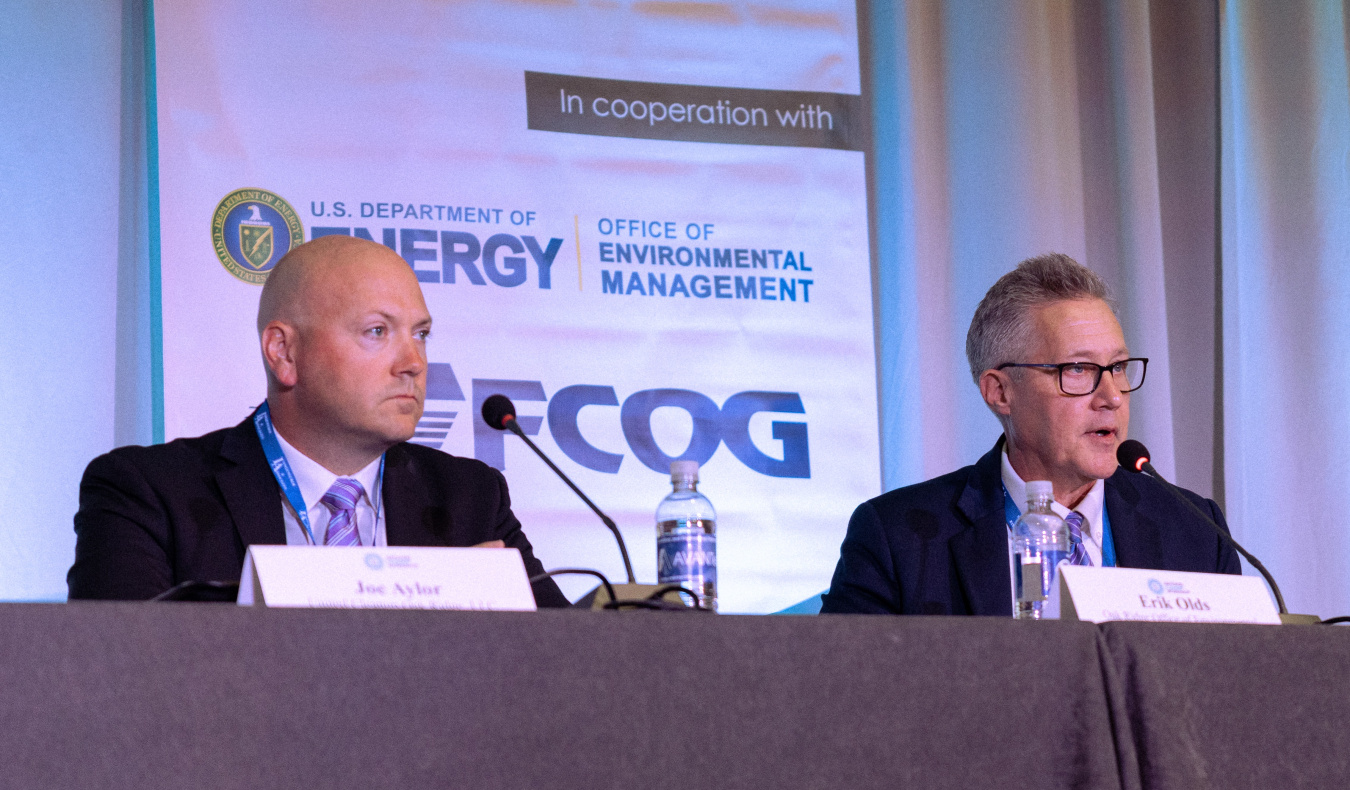A suite of innovative approaches to cleanup that can result in more than $100 million in savings is being evaluated at the Oak Ridge Reservation. September 30, 2025
Office of Environmental Management
September 30, 2025U.S. Department of Energy Oak Ridge Office of Environmental Management Manager Erik Olds, right, speaks to the audience at the 2025 National Cleanup Workshop during the panel session titled, “Enabling Efficiency and Driving Innovation at Oak Ridge.” UCOR Critical Projects Director Joe Aylor is also pictured.
ARLINGTON, Va. — A suite of innovative approaches to cleanup that can result in more than $100 million in savings is being evaluated at the Oak Ridge Reservation, federal and industry representatives said here last week.
“We're basically asking ourselves, what can we do differently, and where can these efficiencies really contribute to the core mission that is cleanup?” said Erik Olds, manager of the U.S. Department of Energy (DOE) Oak Ridge Office of Environmental Management (OREM).
Oak Ridge cleanup contractor UCOR has developed a five-point “efficiency plan” targeting safety, contracting, environment, performance and assessment, UCOR Critical Projects Director Joe Aylor said during a panel session at the 2025 National Cleanup Workshop.
That plan involves components such as an “OSHA-plus framework” for worker safety similar to what the National Nuclear Security Administration (NNSA) uses for some projects, expanded project management authority and a more cooperative approach to audits, Aylor said.
“Early estimates are showing savings specifically within our contract north of $100 million over the next several years,” Aylor said. "This is money that we can sink back into helping accelerate cleanup.”
DOE and UCOR are taking a “deliberate” approach to utilizing new cleanup approaches and making sure they result in “measurable” improvements, Olds said.
“I love that we have those opportunities to look at our toolbox and find things we can do differently, faster and better, but we have to be very deliberate in our approach and what we can choose to change and how we choose to change it,” Olds said. “We want to ensure that our roadmap that we develop, given all of these opportunities, is very precise and it's very clear to our team, so everyone knows the direction that we're heading.”
He also emphasized the need to ensure that new approaches can be sustained going forward.
“Sustainable changes are the best changes, right? We want performance efficiencies that are repeatable and that are consistent over time and teachable,” Olds said. “There's going to be other people sitting in these seats doing these jobs and we want to make sure they can take advantage of the good things that we're putting in place. So we want to ensure that our teams really understand and are prepared to fully support the changed environment.”
Oak Ridge’s efforts to identify innovative and more efficient approaches to cleanup come as DOE as a whole is looking to streamline requirements for its major programs, according to panel moderator John Longenecker, CEO of Longenecker & Associates and managing director of the Energy Facility Contractors Group.
“When the new administration came in, they put an even greater emphasis on streamlining,” Longenecker said. “We know that reducing risk and cleaning up the sites is really good for everyone. It's certainly good for the communities because of the tremendous economic development we can get by freeing up land. It’s also important to NNSA and the [DOE Office of] Science and others to get additional footprint so they can do these critical missions at existing institutions. It’s certainly good for the workers … and at the end of the day for the taxpayers.”
-Contributors: Jordan Anderson, Michael Nartker
To receive the latest news and updates about the Office of Environmental Management, submit your e-mail address.


